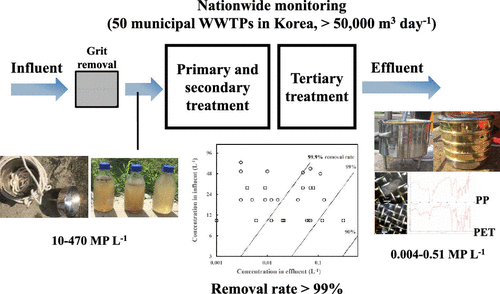当前位置:
X-MOL 学术
›
Environ. Sci. Technol.
›
论文详情
Our official English website, www.x-mol.net, welcomes your
feedback! (Note: you will need to create a separate account there.)
National Reconnaissance Survey of Microplastics in Municipal Wastewater Treatment Plants in Korea.
Environmental Science & Technology ( IF 10.8 ) Pub Date : 2020-01-14 , DOI: 10.1021/acs.est.9b04929 Hee-Jin Park 1 , Min-Ju Oh 1 , Pil-Gon Kim 1 , Gwonbo Kim 2 , Dong-Hwan Jeong 3 , Byoung-Kyu Ju 3 , Won-Seok Lee 3 , Hyen-Mi Chung 3 , Hyun-Joong Kang 1, 4 , Jung-Hwan Kwon 1
Environmental Science & Technology ( IF 10.8 ) Pub Date : 2020-01-14 , DOI: 10.1021/acs.est.9b04929 Hee-Jin Park 1 , Min-Ju Oh 1 , Pil-Gon Kim 1 , Gwonbo Kim 2 , Dong-Hwan Jeong 3 , Byoung-Kyu Ju 3 , Won-Seok Lee 3 , Hyen-Mi Chung 3 , Hyun-Joong Kang 1, 4 , Jung-Hwan Kwon 1
Affiliation

|
Large quantities of microplastics are thought to be emitted to freshwater environments via wastewater treatment plants (WWTPs). To evaluate the occurrence of microplastics in Korean WWTPs, a nationwide study was conducted for the first time in 50 representative WWTPs with large treatment capacities. Grab sampling and laboratory filtration were used for influents, whereas in situ filtration using a custom-made sampling device was used for effluents. The filtrates were pretreated using wet peroxidation and density separation prior to the identification of microplastics with a dissection microscope and Fourier-transform infrared spectroscopy. Pooled analyses of the microplastics revealed that they were predominantly fragment-shaped, and thermoplastics and synthetic fibers were the dominant microplastic materials in WWTPs. The concentration ranged from 10 to 470 L-1 in influents and 0.004 to 0.51 L-1 in effluents. The removal efficiency of microplastics during wastewater treatment was calculated to be 98.7-99.99% in 31 WWTPs. Additionally, WWTPs using advanced phosphorus removal processes exhibited higher removal efficiency than those not implementing such processes. Power-law distribution was successful in describing microplastic particle sizes down to 100 μm, although it was not applicable for smaller particles. This comprehensive monitoring study provides information on the current level and characteristics of microplastics in WWTPs in Korea.
中文翻译:

韩国城市污水处理厂微塑料国家侦查调查。
据认为,大量的微塑料是通过废水处理厂(WWTP)排放到淡水环境的。为了评估韩国污水处理厂中微塑料的存在,首次在全国进行了50个具有较大处理能力的代表性污水处理厂的研究。进水使用抓斗采样和实验室过滤,而废水使用定制采样设备进行原位过滤。使用湿式过氧化和密度分离对滤液进行预处理,然后使用解剖显微镜和傅里叶变换红外光谱法鉴定微塑料。对微塑料的汇总分析显示,它们主要是碎片状的,而热塑性塑料和合成纤维是污水处理厂中主要的微塑料材料。进水的浓度范围为10至470 L-1,出水的浓度范围为0.004至0.51 L-1。在31个污水处理厂中,废水处理过程中微塑料的去除效率经计算为98.7-99.99%。另外,与未实施这种工艺的污水处理厂相比,采用先进的除磷工艺的污水处理厂具有更高的去除效率。幂律分布成功地描述了低至100μm的微塑料颗粒尺寸,尽管不适用于较小的颗粒。这项全面的监测研究提供了有关韩国污水处理厂中微塑料的当前水平和特征的信息。与未实施这些工艺的污水处理厂相比,采用先进的除磷工艺的污水处理厂具有更高的去除效率。幂律分布成功地描述了低至100μm的微塑料颗粒尺寸,尽管不适用于较小的颗粒。这项全面的监测研究提供了有关韩国污水处理厂中微塑料的当前水平和特征的信息。与未实施这些工艺的污水处理厂相比,采用先进的除磷工艺的污水处理厂具有更高的去除效率。幂律分布成功地描述了低至100μm的微塑料颗粒尺寸,尽管不适用于较小的颗粒。这项全面的监测研究提供了有关韩国污水处理厂中微塑料的当前水平和特征的信息。
更新日期:2020-01-15
中文翻译:

韩国城市污水处理厂微塑料国家侦查调查。
据认为,大量的微塑料是通过废水处理厂(WWTP)排放到淡水环境的。为了评估韩国污水处理厂中微塑料的存在,首次在全国进行了50个具有较大处理能力的代表性污水处理厂的研究。进水使用抓斗采样和实验室过滤,而废水使用定制采样设备进行原位过滤。使用湿式过氧化和密度分离对滤液进行预处理,然后使用解剖显微镜和傅里叶变换红外光谱法鉴定微塑料。对微塑料的汇总分析显示,它们主要是碎片状的,而热塑性塑料和合成纤维是污水处理厂中主要的微塑料材料。进水的浓度范围为10至470 L-1,出水的浓度范围为0.004至0.51 L-1。在31个污水处理厂中,废水处理过程中微塑料的去除效率经计算为98.7-99.99%。另外,与未实施这种工艺的污水处理厂相比,采用先进的除磷工艺的污水处理厂具有更高的去除效率。幂律分布成功地描述了低至100μm的微塑料颗粒尺寸,尽管不适用于较小的颗粒。这项全面的监测研究提供了有关韩国污水处理厂中微塑料的当前水平和特征的信息。与未实施这些工艺的污水处理厂相比,采用先进的除磷工艺的污水处理厂具有更高的去除效率。幂律分布成功地描述了低至100μm的微塑料颗粒尺寸,尽管不适用于较小的颗粒。这项全面的监测研究提供了有关韩国污水处理厂中微塑料的当前水平和特征的信息。与未实施这些工艺的污水处理厂相比,采用先进的除磷工艺的污水处理厂具有更高的去除效率。幂律分布成功地描述了低至100μm的微塑料颗粒尺寸,尽管不适用于较小的颗粒。这项全面的监测研究提供了有关韩国污水处理厂中微塑料的当前水平和特征的信息。









































 京公网安备 11010802027423号
京公网安备 11010802027423号